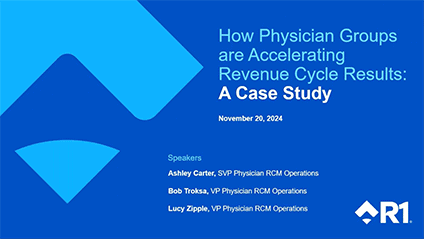Just days into 2021, industry leaders such as Kaufman Hall began projecting that hospitals and health systems were in for another tumultuous financial year. in addition to recovering from the previous year’s hard hits, healthcare organizations would be taking a few new ones, too. So far, this prediction has proven accurate time and again, from the winter COVID-19 surge continuing to drive up expenses – such as the 14% increase in labor costs and 13% increase in supply costs – to the continuation in lower patient volume due to stalled non-coronavirus services at acute care facilities.
Due to the industry’s uncertain economic forecast, CFOs and other healthcare executives have prioritized cost containment and reduction. Cutting costs may prove difficult, however, as most hospitals were already operating with razor-thin margins – and had likely maxed out every revenue cycle resource – long before COVID-19.
While leaders have been tasked with cost containment, they must also overcome evolving challenges related to collecting from their two sources of revenue:
- Payers – Value-based reimbursement is unavoidable; CMS plans to transition 100% of Medicare providers to two-sided risk arrangements by 2025, and Aetna, Anthem and UnitedHealth Group have already changed nearly half of their reimbursements to value-based models. Many hospitals, however, haven’t fully prepared their revenue cycle for the transition from fee-for-service payments. In addition to different processes and technology requirements, value-based payment models also place new demands on the revenue cycle team. For instance, back-office staff needs a broad and deep understanding of the reporting requirements for each type of value-based contract, including how to obtain the necessary data for claim submission. In addition to variations in the overall data reporting requirements for each value-based model, requirements also differ from payer to payer – necessitating additional technology configuration to ensure the proper workflow.
- Patients – While consumerism led to new revenue cycle expectations well before COVID-19, today’s hospitals face additional challenges. An overwhelming number of patients have experienced financial setbacks; for example, the U.S. had roughly 9.5 million fewer jobs in February 2021 than it did the prior February. As a result, patients may be less willing or able to pay their medical bills than they were before the pandemic. Patients’ demands related to price transparency and cost estimates go far beyond the federal price transparency law’s mandate. If a hospital’s strategy only incorporates regulatory compliance, leadership must take steps to fully address consumer and patient expectations – ensuring they have a convenient, user-friendly and seamless experience as they research costs, compare pricing and schedule care. In addition, patients’ caution about returning to acute care facilities means they want a “contactless” experience as much as possible – especially in administrative and financial tasks.
CFOs are in the unenviable position of not only following the edict to manage costs, but also ensuring their organization collects every dollar owed from both sources of revenue.
Evaluating the high cost of fixed costs
Looking at the numerous patient and payer-related demands, it’s clear that hospitals must leverage the right processes, technology and skillsets within RCM if they want to increase revenue. What’s less clear, though, is how hospitals will be able to leverage the right resources in each of these areas, while at the same time containing costs. A key part of the answer lies in removing fixed costs from the revenue cycle.
Consider these facts related to labor costs, the most expensive item in a hospital’s operations budget:
- Salary and benefit costs – Frequently, healthcare provider budgets don’t compensate for the 5% to 10% annual increase in salary and benefit inflation, yet this increase can quickly add up. In an area with a higher cost of living, a revenue cycle team with 80 associates may have a total salary cost approaching $4 million; over five years, this cost may increase 25% to 50%, or $5.1 to $6.44 million.
- Recruiting and turnover costs – Turnover can cost employers more than 33% of an associate’s annual salary. In addition, hiring and onboarding expenses related to advertising, pre-employment screening and training for areas such as IT systems and compliance requirements continue to rise. It typically takes 8 to 12 weeks to replace a knowledgeable worker; added to that, employees need a minimum of 6 to 8 weeks before they’re fully productive. Therefore, if a former associate was responsible for generating $110,000 in revenue each month, that’s a $55,000 loss over two months.
If the removal of these fixed costs seems too good to be true, it isn’t. It only requires a different way of approaching revenue cycle management – namely, an RCM partnership.
The revenue cycle as a competitive advantage
An RCM partnership gives hospitals the significant advantage of a variable rather than fixed cost structure. For example, no matter their patient volume, the revenue cycle team in the earlier example would incur the same $4 million in salary and benefit costs. With an RCM partnership, however, hospitals have a variable cost structure based on a small fee per patient claim. If hospital volume is drastically diminished – for instance, in the early stages of the COVID-19 pandemic – total RCM costs decrease as well. There are no fixed RCM costs to manage; wage and benefit inflation is no longer a challenge. This variable cost structure makes navigating sudden changes in patient volume, whether up or down, much easier and helps protect the bottom line.
With an RCM partnership, adjustments in staff size to accommodate business expansion or contraction isn’t an issue, either. When 43,000 healthcare jobs were lost in March 2020, R1 clients didn’t have to worry about revenue cycle staff furloughs or layoffs. Similarly, as the healthcare industry transitions into growth mode, our clients don’t have to worry about coping with sudden increases in patient volume or hiring skilled staff. They can rest assured they’ll always have access to the talent required for optimal revenue cycle operations.
R1 offers numerous other benefits that help hospitals meet every financial challenge , such as the emerging payer and patient demands referenced earlier. Our clients run a single, streamlined revenue cycle platform fueled by intelligent automation, which leverages the ideal technology – for example, robotic process automation and machine learning – or staff to complete each task in a cost-effective manner. Best practice processes hardwired into the technology drive expedience and accuracy among revenue cycle staff, while digital self-service options foster an excellent patient experience.
The importance of speed to value
In an era when reducing costs is of the greatest importance, R1 delivers speed to value , taking full accountability for meeting agreed-upon KPIs and delivering guaranteed cost reductions within the specified timeframes. Our partnership models consistently deliver tangible ROI such as up to a 5% increase in net patient revenue and up to a 20% reduction in cost to collect. We offer various types of engagements, and our approach is tailored to each organization’s unique needs.
Contact us for an assessment of your revenue cycle and learn how a partnership with R1 can improve your financial outcomes and patient experience.
Author Bio: Peter Hall is Vice President of Enterprise Partnerships at R1 RCM.





